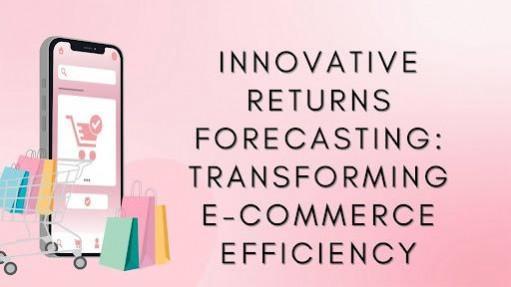
Online commerce is evolving, and the challenge of managing product returns has sparked a wave of innovation. In this article, groundbreaking approaches to forecasting returns are explored as a means to enhance both customer experience and operational performance. Based on the research of Shivendra Kumar, an established expert in e-commerce analytics, this work offers fresh perspectives and actionable insights. The author's pioneering contributions have set a new benchmark in predictive returns management.
Revolutionizing Returns Management
Traditional views of returns management have long regarded product returns as unavoidable costs. However, innovative forecasting techniques are turning this liability into a strategic asset. By leveraging predictive analytics, businesses are now capable of accurately anticipating return volumes and timing, allowing them to better align resources and streamline reverse logistics. These advancements not only reduce operational waste but also foster improved customer interactions.
Data Integration: The New Backbone
Modern forecasting models thrive on the seamless integration of diverse data streams. Sophisticated systems combine transaction records, customer behavior metrics, product metadata, and policy adjustments to deliver comprehensive insights. This holistic approach enables the development of more accurate and responsive forecasting models. Such integration has proven to be essential for adapting to varying return patterns across different product categories and timeframes.
Advanced Modeling Techniques
Innovative forecasting methods are embracing a range of analytical techniques. Time-series models, enhanced with lagged variables, capture temporal dynamics in both sales and returns. Meanwhile, machine learning approaches, including gradient boosting and hybrid models, excel in managing the non-linear and multidimensional nature of return data. These advanced techniques have demonstrated significant improvements in prediction accuracy, leading to better resource allocation and reduced costs. The use of sophisticated algorithms has also paved the way for more agile and dynamic forecasting systems.
Dynamic Policy Optimization
One of the most compelling innovations is the application of dynamic policy frameworks. By predicting return probabilities with high precision, businesses can tailor their return policies to individual transactions. This enables a flexible response to varying risk profiles and customer preferences. Dynamic policy optimization not only streamlines operational processes but also enhances the overall customer experience.
Enhancing Customer Experience
Innovative forecasting models are transforming the customer journey by providing clarity and predictability in the returns process. Enhanced transparency about return timelines and personalized communication channels have contributed to higher satisfaction rates. Customers appreciate knowing when their returns will be processed and receiving tailored updates throughout the process. The resulting improvement in post-return purchase behavior underscores the value of integrating predictive analytics into customer service strategies.
Operational Efficiency Through Innovation
Accurate forecasting drives tangible operational benefits. Improved prediction accuracy translates to better scheduling of labor, optimized logistics, and reduced processing costs. Key performance indicators, such as mean absolute percentage error and inventory recovery time, have become critical benchmarks for measuring success.
Future Impact of Predictive Analytics
As e-commerce continues to expand, the role of predictive analytics in returns forecasting is set to grow. Future innovations may incorporate real-time data integration, further enhancing model responsiveness and accuracy. These advancements are likely to drive both operational efficiency and improved customer experiences, creating a virtuous cycle of continuous improvement. The integration of advanced analytics in returns management represents a fundamental shift in how businesses approach customer satisfaction and resource optimization. Industry experts predict that continuous innovation in data analytics will further revolutionize returns management, driving unprecedented levels of efficiency and customer trust.
In conclusion, In the rapidly shifting landscape of online commerce, innovations in returns forecasting are redefining operational and customer service paradigms. By transforming returns from a cost burden into a strategic tool, businesses can achieve significant efficiency gains and elevate the overall customer experience. As this field evolves, the pioneering research of Shivendra Kumar continues to inspire new strategies and set industry standards for excellence.









